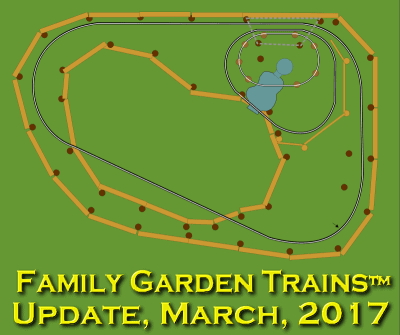 | |||
 |
 |  | |
 |  | ||
 |  | ||
 |  | ||
 |  | ||

| Please Read: How to Help Our Site at No Cost to You - Some of our articles contain recommendations for products we like and vendors we personally trust. Some of those vendors may pay us a very small commission if you click on a link and buy their products. This costs you nothing at all and helps offset the costs of what we do. So if we point you to something you decide to buy later, please make certain you come back through our site and click on the link directly. Thanks. |

|
March, 2017 Update from Family Garden TrainsTMNote: This is the web version of a newsletter from the Family Garden TrainsTM web site, which publishes information about running big model trains in your garden as a family activity.If you are not subscribed to the Family Garden Trains newsletter, and you would like to subscribe, please join our Mailing List, and specify that you want to receive e-mail updates. Also, if you would like to subscribe to our free newsletter for indoor railroads and seasonal display villages, please join the "Trains-N-TownsTM mailing list. You can subscribe to either, both, or neither, and we will just be glad to be of service, no matter what you decide. Fine Print: If you are receiving our e-mail updates and you no longer wish to subscribe, please e-mail me with a "Please Unsubscribe" message (worded any way you wish), and we will graciously remove you from our list. In This IssueIf you've been following our adventures, you know that we moved in November of last year, after having one more run of the trains in October. The house we moved to has a huge lawn, but also had a crater, left behind when a former owner "filled in" a 15'-deep 18'x32' swimming pool by having a dump truck back up to it and unload "clean fill dirt" (including construction waste) into it. That story is part of our first article below.In the meantime, we've been planning, of course. Four 4'x12' raised vegetable garden beds, and the first section of a planned garden railroad. And that's where this story may seem to get on topic. How does a person who has researched just about every kind of garden railroad construction and tried most of them approach planning a brand new railroad? To be honest, a lot has changed since I first broke ground in 1999, following instructions written by people who live in the desert, where weed growth is never a consideration. So I've learned a lot of things the hard way. In addition, the market has changed radically, with our hobby's only full-service provider of standard-gauge railroad equipment going bankrupt. Yes, others have stepped in, but it will be a very long time before the variety of quality choices gets caught back up to pre-2007 levels. On the other hand, I have also realized over the years that to 99% of my visitors, the kind of trains I run is less important than the setting they run in, and - frankly - my ability to run trains at something close to a moment's notice, which was seldom possible with the conventional construction methods I used starting out. In the effort to avoid old mistakes, I'll probably be making all new ones. And here are some of the principles I hope to follow in the coming months:
The little picture in the title shows one approach I was planning, with three concentric ovals of track at three different levels, with ponds and waterfalls. The big open area in the middle left was going to get a flexible pond liner eventually. Initially, I was going to go with the 2"x6" roadbeds fastened directly to on posts, with dirt piled up to the level of the roadbed in each of the three planned levels. Nowadays, I'm thinking a little differently. Like three concentric "decks" each of which will be a sort of shallow planter box where I can arrange my track, buildings, and plants to my heart's content, without worrying that dandelions and thistles will ever really get a chance to root. As planned now, each level of all three ROWs will go through a tunnel at the "back corner," which will provide access and temporary storage. Also, I am only going to try to get the top two levels done this year, as a sort of "proof of concept." If it works as well as I think it should, I'll add the lower level next year. Or revise my plans and try again. :-) I've already changed this several times, but it's still in planning so that graphic may be as close as any to the end product. There will be more detail in the New Boston and Donnels Creek section of the site, while hopefully any "lessons learned" during the process will find their way to new articles. Stay tuned. Other things have changed, since 1999, too. For me the loss of AristoCraft was huge - they advanced the standard gauge segment of the hobby far more than anyone else, while striving to keep prices on their entry-level sets affordable. That said, the narrow gauge manufacturers (LGB, Bachmann, and HLW) are steaming along, while Piko and USA trains are keeping standard gauge available for us diehards. I still have products from almost all of those companies (and a few others) in my storage area, so loss of my favorite manufacturer won't impact me like it would some people. But I do plan to build the new New Boston and Donnels Creek using products, materials, and methods that are available today. So folks who are just getting into the hobby should be able to follow along just fine, if that makes any sense. In fact, I'm thinking of building the railroad in stages, each of which could be a freestanding railroad, if a family following my progress has to stop at the first or second stage. We'll see.
My first garden railroad started as a loop of track set in a gravel trench on a slightly raised bed around a 100-gallon pond. There wasn't much planning involved, really, since back in 1999, there were only a couple "approved" ways to build a garden railroad, and I was ignorant enough to just do things the way people told me. Unfortunately, the result of that meant that I had to dig up most of the roadbed a few years later and pour concrete footers where the gravel had been - the gravel that moles, voles, and chipmunks loved tunneling through, and where weeds grew joyously up through the track.
|

 
|
Note: Family Garden TrainsTM, Garden Train StoreTM, Big Christmas TrainsTM, BIG Indoor TrainsTM, and BIG Train StoreTM are trademarks of
Breakthrough Communications (btcomm.com). All information, data, text, and illustrations on this web site are
Copyright (c) 1999, 2000, 2001, 2002, 2003, 2004, 2005, 2006, 2007, 2008, 2009, 2010, 2011, 2012, 2013, 2014, 2015, 2016, 2017by
Paul D. Race. Reuse or republication without prior written permission is specifically
forbidden.
Family Garden Trains is a participant in the Amazon Services LLC Associates Program,
an affiliate advertising program designed to provide a means for sites to earn advertising
fees by advertising and linking to amazon.com.
For more information, please contact us
 |  |
| Visit related pages and affiliated sites: | |||||
| - Trains and Hobbies - | |||||
 |  |
 |
 |
 |  |
 |

|

|  |
 |

|
| - Christmas Memories and Collectibles - | |||||
 |

|
 |

|
 |

|
| - Family Activities and Crafts - | |||||
 |

|

|

|

|

|
| - Music - | |||||

|
 |
 |

|

|

|

|

|

|

|

|

|

|

|

|

|

|

|
 Planning the New New Boston and Donnels Creek Railroad
Planning the New New Boston and Donnels Creek Railroad About Maccourt Pond Liners
About Maccourt Pond Liners